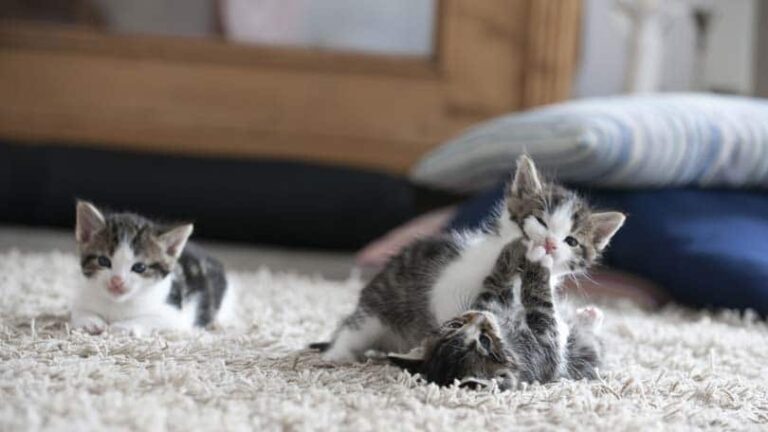Cat Litter Box Training: Tips and Techniques
Congratulations on bringing a kitten or full-grown cat into your home. Being a pet parent is emotionally rewarding and comforting. Cats are naturally clean animals, and training a kitten to use the litter box isn’t challenging.
Since felines have always buried their poop, keeping it hidden from predators and prowling cats muscling in on their territory, a litter box is a natural extension of their habit.
Choosing the right litter pan for your kitty is important. You can start with something basic or opt for an advanced self-cleaning system. The advantage of the litter box system is that cleaning is almost effortless.
Here are some insights on how to go about training or retraining a cat or kitten.
Importance of Litter Box Training for Cats
Investing time in litter box training helps promote a healthy and long-lasting bond between you and your cat.
Indoor cats need a place to do their business in comfort. As a pet owner, you need your kitty to learn to use the litter box because urine and feces emit a potent ammonia odor that you must deal with promptly. Cat poop can carry toxoplasmosis, which is transmitted to people through poop. It can cause health issues in some people.
Further, allowing poop and pee on soft furnishings damage your property and is unhealthy.
How to Litter Train the Cat
As soon as you can tear yourself away from snuggling your new kitty, introduce your cat to the litter box. Unless you rescued a stray kitten off the street, you’ve already planned ahead and purchased the necessary supplies like food, litter box, litter, and toys.
- Choosing the Right Litter Box Location
Most cats prefer privacy when they do their business. Many people use a crawlspace under the stairs, the laundry room or mud room, or a corner in the garage the cat can access at any time. Ideally, you want the litter box away from heavy traffic and cat food dishes.
- Preparing the Litter Box
If you’re still shopping for essential supplies, read up on brands and types of kitty litter to get you started. Litter boxes have come a long way, and cat accessories are endless.
Plain litter boxes work well but require a bit more effort. However, the cat litter market has exploded with many automated litter pans, making scooping easier.
For best results, fill the bottom of the litter tray with about two inches of clumping litter to allow the kitty enough material to dig and cover its tracks. Tofu or rice litter is an excellent alternative.
Gently set the kitten on the litter and allow it to experience the texture, scent, and surrounding space. A kitten may not need to relieve itself instantly, so give it some time. It’s about introducing it to the concept and location.
Tip: If your pet has access to a large home, make sure you provide litter boxes on all levels to avoid accidents. World Animal Foundation recommends using automatic litter boxes to ensure a fresher, cleaner home environment.
- Create a Routine
Training a kitten is easy, but it takes practice for you and your pet. A great time to whisk your cat off to the litter box is right after it has eaten or drunk. Kittens most often have to eliminate immediately after eating.
If you’re not fast enough and they start eliminating, don’t panic. Stay calm, and gently carry the cat to the box to reinforce that this is where it should do its potty. When they void in the right place, shower them with affection.
Tip: Every cat and kitten is unique and might have had some bad experiences with household appliances or loud noises. If your pet is unhappy about the litter box, move it. Also, if the tray is in a high-traffic or noisy area in the laundry room, rethink your plan until the kitten has had time to build confidence.
- When to Begin Training Your Cat
Adult cats already know how to use the litter box because their instinct is to go in a sandy or grainy spot. If you have large potted plants and don’t provide sufficient litter boxes, any animal may be confused about where to go. With some coaxing, they’ll figure it out.
Kittens need a few lessons about where it’s appropriate to go. Feline moms stimulate their kittens for the first few weeks, and yes, they eat the poop and pee.
When kittens are about four weeks old, it’s time to introduce them to the litter box. Kittens usually get weaned from their moms at this age, so it’s an excellent time to encourage the transition.
Tip: Remember to reward good behavior. Don’t freak out if your pet has an accident. Simple household items like vinegar, dish soap, baking soda, cloths, and hydrogen peroxide will clean and eliminate any odors.
Tips Helpful to Litter Train Your Cat
Being prepared for the arrival of a new pet is important–have all the gear ready. Many people find confining a new pet to a few rooms is the best method without overwhelming the animal. It also allows you to protect the animal from harm.
- Introduce Your Cat to Its Litter Box
When you bring the adorable furball home, immediately introduce your cat to the litter box location.
- Learn Your Cat’s Schedule
Most kittens need to go poop right after their meals, so whisk them to the litter box as soon as they’re sated. Older cats might not be on the same schedule, but I encourage them nonetheless. They usually lick themselves after eating.
- Play With Your Cat Near the Litter Box
Make the litter box a comfortable and inviting space. Most cat owners find that playing with their new arrivals near the litter box makes them comfortable.
- Reward the Cat For Rightly Using the Litter Box
When you bring the new kitten home, watch it do its business, whether eating, sunning, or pooping. Follow them quietly and reward them with praise and affection when they relieve themselves in the litter tray.
- Never Punish Your Kitty
Seriously, you can’t argue with a cat and win. If your pet has an accident, carry it toward the litter box and gently set it down. Rubbing your cat’s nose in it won’t solve the problem. Instead, clean the soiled area immediately and thoroughly.
- Special Focus on the Cleanliness of the Litter Box
Cats are clean animals, and your job is to create a clean environment. If you have more than one cat that needs to eliminate waste, have more than one litter box, as cats can be territorial. Scoop the litter tray frequently, and don’t let feces and urine accumulate. Top up the clumping litter level again.
Techniques to Litter Train Your Kitty
Cats can be finicky. Noisy automated litter boxes or loud appliances like vacuums might scare the cat. Create a positive and quiet environment for your cat’s potty habits.
- Get an Appropriate-Sized Litter Box
Some people have good luck and train their cats to use a simple plastic tray. Cardboard boxes aren’t ideal, and urine will soak through. Vets recommend that the tray be about one and a half times the cat’s length to allow ample space to turn around and bury its treasure.
- Decide on a Covered or Uncovered Litter Box
Some cats send litter flying when burying their poop and pee. For those cats, a covered box is best. Cats are good negotiators, and they usually get what they want.
- Choose the Right Type of Litter
As we said, preparing for the arrival is a good idea. Clumping litter is a preferred type, but there are also environmentally friendly options. Tofu cat litter is a great choice and easy to scoop.
Tip: Cleaning the litter box is only nasty if you neglect it. If you tackle it daily, it’s just a scoop. It also saves you from having a stinky pan that you must wash sooner rather than later.
- Find the Right Place to Put the Litter Box
Since every house is different, finding a quiet place can be challenging. A small two-piece bath might do in a pinch as long as your cat can access the pan anytime. Laundry or utility rooms work well and provide your cat with the desired privacy.
- Avoid Any Distractions
Some cats are okay with noises, but until a cat gets used to its new home, don’t put the litter box near a loud furnace, AC unit, or washing machine.
Assisting Measures to Take If the Cat Doesn’t Use the Litter Box
Occasionally, some cats refuse to use the facilities. That means you need to work a little harder. If the cat has used the box regularly in the past and is now soiling the other areas of the house, it might have medical issues. Cats are usually fully trained by six months.
Any cat might develop a litter box problem indicating poor health or territorial dispute.
- Recheck the Litter Box Setup
If you notice repeating accidents, investigate the box setup. Something simple, like a broom or vacuum wand, can make kitties uncomfortable. If cats have to share, get an extra tray.
- Try Changing Either the Litter or Litter box
Not all cats like every type of litter. Cats are sensitive and might be offended by the litter’s smell or texture—experiment with changing the litter brand or swapping out the tray.
- Use Pheromone Diffusers Around the Litter Box
Pheromone diffusers might work if your feline is experiencing anxious behavior. It works effectively with some animals but could prevent a mess. Talk to your veterinarian.
- Get Your Cat a Vet Check
Most cats don’t like to make a mess, but accidents happen. If your kitten or adult cat continues to avoid the litter box, and you’ve tried all the remedies, it’s time to consult a vet. Cats can develop urinary tract infections or cystitis and need medical intervention.
Parting Thoughts
Training a kitten to use the litter is usually very easy unless the kitten or cat has had some traumatic experience that makes them fearful of the litter tray. With some coaxing, rewarding, and patience, you should be able to address the problem.

Nato is a content writer and researcher with a background in psychology who’s eager to explore the wonders of nature. As a travel enthusiast and animal lover, she hopes to inspire others to discover and cherish the beauty and importance of the natural world.







